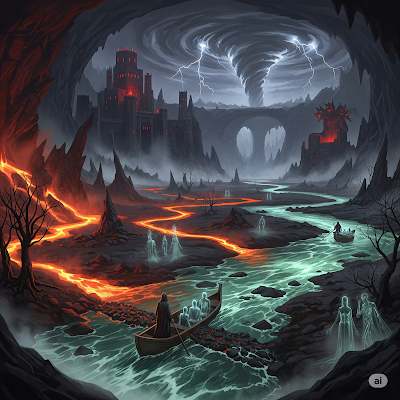Secrets Of The Underworld: Realms Of The Dead, Demons, And Hidden Dimensions
For thousands of years, stories ofthe underworld — a hidden realm beneath our own, have stirred fear, fascination, and spiritual exploration. Is it just an ancient myth? A religious warning? Or could it be a real metaphysical domain that souls travel through after death?
Across cultures and centuries, mystics, philosophers, and shamans have described an unseen world: a place of spirits, judgment, transformation, and sometimes rebirth. This in-depth exploration uncovers the layers of the underworld from ancient texts to modern occult beliefs.
What Is the Underworld?
The underworld is often confused with hell, but in truth, it is much more complex. In myth, it's the realm of the dead — but in esoteric teachings, it is a spiritual dimension where souls encounter karmic tests, shadow beings, and deep personal truths.
Manly P. Hall, famed occultist and author of The Secret Teachings of All Ages, called the underworld “the chamber of spiritual alchemy,” where the soul is refined before ascending. He claimed that it’s not a place of torment, but of inner transformation.
The Hidden Dimensions Beneath Our World
In metaphysical science and spiritual teachings, the underworld is often described as part of the lower astral plane — a dense vibrational level of existence that overlaps with the material world.
Edgar Cayce, the “sleeping prophet,” gave multiple readings that spoke of souls becoming “earthbound” in astral states due to fear, trauma, or unfinished business — essentially trapped in underworld-like conditions.
- Astral Underworld: A space of dense, chaotic energies where fear and unresolved emotions dwell.
- Earthbound Souls: Spirits stuck between realms — often mistaken as ghosts.
- Lower Entities: Beings attracted to emotional pain. The 16th-century mystic Paracelsus called them “rogue elementals.”
The Underworld in Ancient Cultures
Let’s explore how ancient civilizations described this dark yet sacred realm:
— Egyptian Duat
The Egyptians believed that after death, the soul enters Duat, ruled by Osiris. It journeys through twelve gates facing monstrous beings and divine judges. The heart is weighed against a feather — a test of purity. Only the righteous are reborn in the Field of Reeds.
— Greek Hades
In Greek mythology, the soul crosses the River Styx, guided by the ferryman Charon. Hades is not just punishment — it includes the Asphodel Meadows (for ordinary souls), Elysium (paradise), and Tartarus (punishment). These realms mirror our deeds in life.
— Yoruba Orun Apadi
In Yoruba cosmology, the underworld is called Orun Apadi — the “realm of broken pots.” It's a place for wandering or disturbed souls who have not completed their earthly journey. Ancestors in this realm are often venerated for guidance and protection.
Occult Beliefs: Shadow Work, Gates, and Transformation
Rudolf Steiner, founder of Anthroposophy, wrote about spiritual realms where souls undergo purification. He described a “threshold” between the physical and spiritual worlds that must be consciously crossed — much like entering the underworld.
Shadow Work
Carl Jung coined the term “shadow” to describe the unconscious aspects of ourselves. Shadow work, in esoteric paths, is a descent into the underworld of the mind — confronting fears, traumas, and suppressed desires to achieve enlightenment.
The 7 Gates of the Underworld
Occult texts, including Babylonian myth and Sumerian epics, speak of gates that lead to the underworld. Inanna's Descent into the underworld reveals seven gates where she removes symbolic layers of power — a metaphor for ego death and spiritual rebirth.
- Gate of Flesh – Releasing physical attachment
- Gate of Fear – Facing inner demons
- Gate of Truth – Seeing one’s true self
- ...and so on, until the soul is naked before the void.
Entities That Dwell Below
The underworld is not empty — it teems with spiritual life. Here are the beings most often associated with this plane:
- Earthbound Spirits – Souls that failed to move on after death, tied to emotions, trauma, or possessions.
- Ancestors – Venerated in many traditions, especially African spirituality, where they act as guides from the other side.
- Lower-Dimensional Entities – Often called demons, though many are just confused, fragmented energies.
Eliphas Levi, a 19th-century French occultist, believed these beings were both real and symbolic — reflections of our spiritual condition and collective fears.
The Underworld in Entertainment: Fiction or Hidden Truth?
From Hollywood’s horror films to Nollywood’s spiritual thrillers, the underworld shows up everywhere. Why? Because it reflects universal truths: the fear of death, the mystery of the afterlife, and the need for redemption.
Authors like Dante (The Inferno) and filmmakers like Jordan Peele (Us) portray underworlds as mirrors — where characters must descend to confront inner truths. This is not just fiction. As Manly P. Hall wrote, “All myths are truths hidden in symbols.”
A Thought For Seconds
It is not all about believing in the underworld as a literal realm, a metaphor, or an energetic frequency — one thing for sure it teaches: growth comes from the descent. Only by facing our shadows, our deaths (symbolic or real), and our fears, can we truly transform.
“To descend into the underworld is to confront yourself at your rawest, and only then can you rise transformed.” — Manly P. Hall
Stay curious. The realms beyond are not always what we’ve been told…




Comments